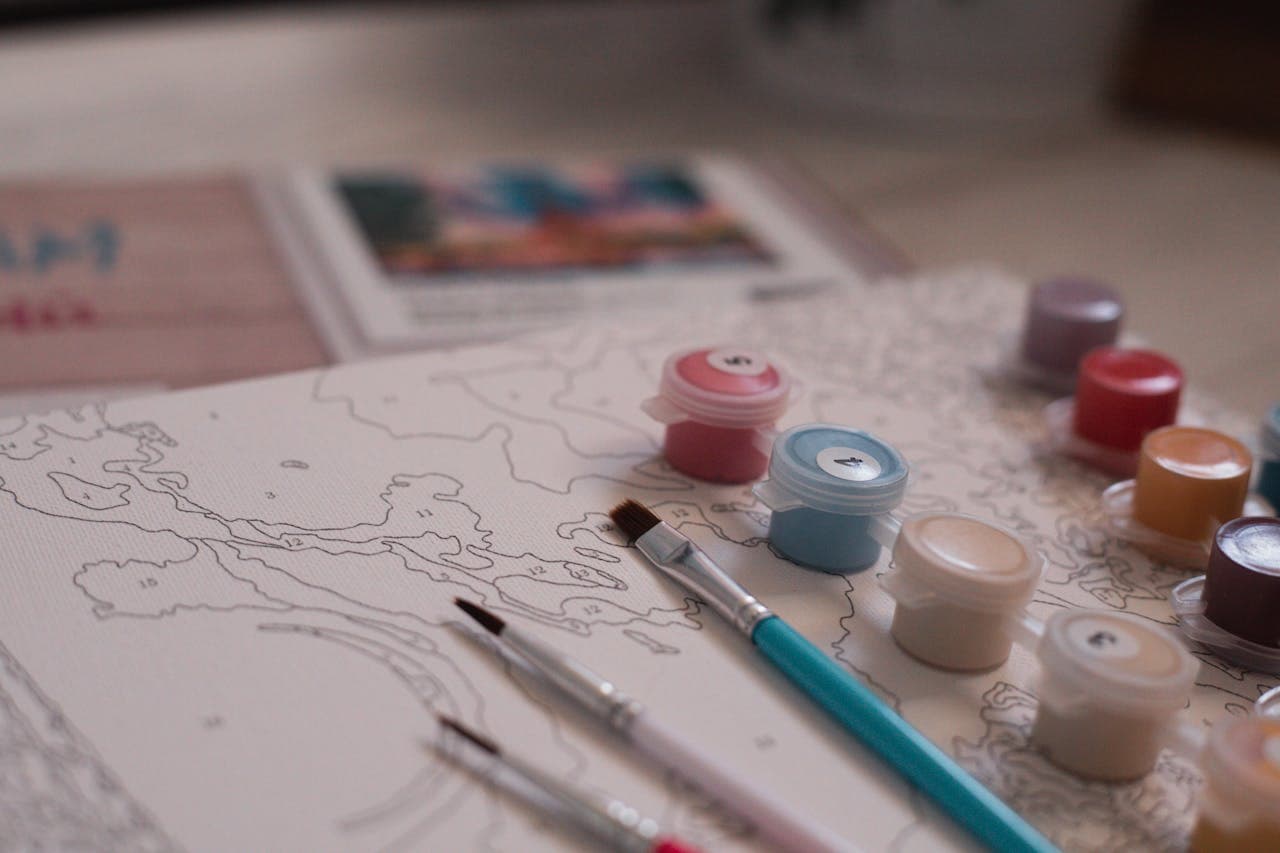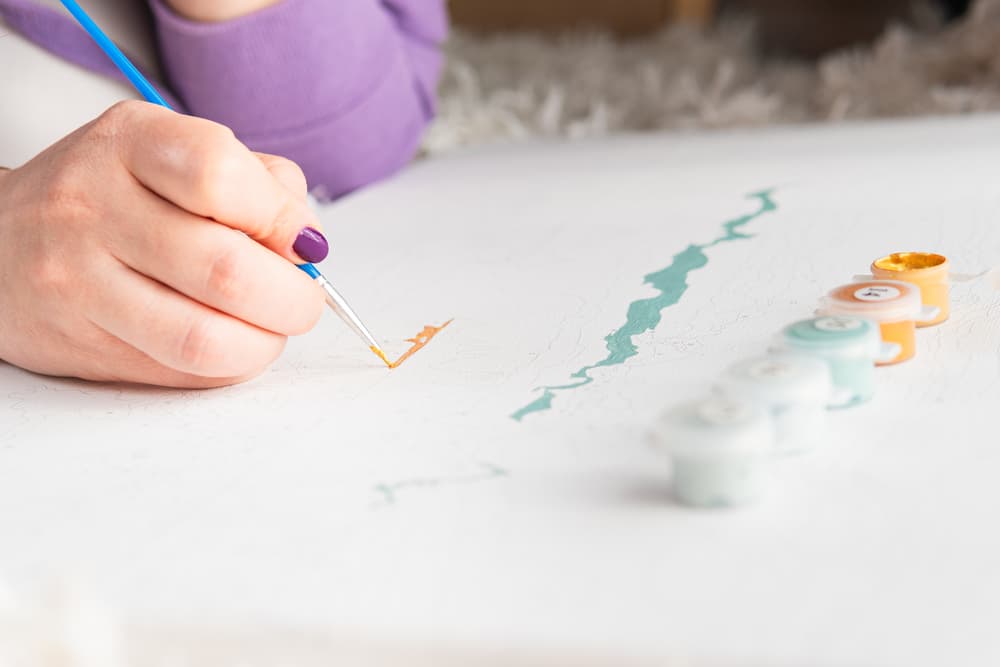How canvas and pre-framed paint by numbers kits differ in use and experience
Paint by numbers kits offer an enjoyable way to create art, but the choice between canvas and pre-framed options can significantly impact your painting experience. Canvas kits provide flexibility and a traditional painting feel, allowing artists to stretch and frame the artwork as desired. Pre-framed kits, on the other hand, offer convenience and immediate stability, eliminating the need for additional preparation before painting.
Canvas paint by numbers kits typically include a rolled canvas that requires flattening before use. This format allows for easier shipping and storage but may require extra steps to prepare for painting. Pre-framed kits come ready to paint, with the canvas already stretched over a wooden frame, providing a taut surface that’s less likely to wrinkle or move during the painting process.
For those seeking a more personalised experience, custom number painting options are available. These kits allow artists to transform their own photographs into paint by numbers projects, adding a unique touch to the artwork while still enjoying the structured approach of numbered sections.
Key Takeaways
- Canvas kits offer flexibility but require preparation, while pre-framed kits provide immediate painting readiness
- Pre-framed options ensure a stable painting surface, reducing the risk of canvas movement or wrinkling
- Custom paint by numbers kits allow for personalised artwork creation using your own photographs

Understanding Paint by Numbers Kits
Paint by numbers kits offer a structured approach to creating artwork. These kits provide numbered canvases and corresponding paints, allowing artists of all skill levels to produce detailed paintings.
Basics of Paint by Number
Paint by numbers kits consist of a pre-printed canvas divided into numbered sections. Each number corresponds to a specific colour. Artists fill in the sections with matching paints to create a complete image.
The process is straightforward: match the paint colour to the numbered area and apply it carefully. This method helps beginners understand colour placement and shading techniques.
Most kits use acrylic paints, which dry quickly and are easy to work with. The numbered system guides artists through the painting process, building confidence and skills along the way.
Types of Paint By Numbers Kits
Paint by numbers kits come in various styles to suit different preferences and skill levels:
- Standard kits: Pre-designed images on canvas
- Custom kits: Personalised images from photos
- Pre-framed kits: Canvas stretched on a wooden frame
- Advanced kits: More complex designs with smaller sections
Beginners often start with standard kits featuring simpler designs. As skills improve, artists may move to more intricate patterns or custom designs.
Pre-framed kits offer convenience, eliminating the need for separate framing. Custom kits allow artists to paint meaningful personal images.
Materials and Tools Provided
A typical paint by numbers kit includes:
- Numbered canvas
- Set of acrylic paints
- Paint brushes (various sizes)
- Reference sheet
Additional items may include:
- Wooden frame (for pre-framed kits)
- Magnifying glass (for detailed work)
- Extra paint (for touch-ups)

High-quality kits use durable canvases and vibrant acrylic paints. Brushes vary in size for different detailing needs. The reference sheet helps artists visualise the final image and track progress.
Some kits provide extra paint to ensure sufficient coverage. A magnifying glass can be helpful for working on tiny, intricate areas of the design.
Painting Techniques and Finishing Touches
Mastering paint by numbers involves key techniques and final steps to elevate your artwork. From starting your painting journey to displaying the finished piece, each stage offers opportunities to enhance your creation.
Steps to Begin Your Painting Journey
Start by organising your paint by numbers kit. Lay out your canvas, brushes, and paints. Check that all colours match the numbered areas on the canvas. Apply a thin coat of gesso to the canvas for better paint adhesion and brighter colours.
Begin painting from the top of the canvas, working your way down. This prevents smudging as you progress. Start with lighter colours before moving to darker shades. This technique helps maintain colour vibrancy and prevents accidental mixing.
Use small brushstrokes to fill in each numbered section. Take breaks to avoid hand fatigue and maintain accuracy. Clean brushes thoroughly between colour changes to keep your palette pure.
Enhancing Your Artwork
Pay attention to detail as you near completion. Use a fine-tipped brush for intricate areas. Add extra layers to darker sections for depth. Allow each layer to dry before applying the next.
Consider blending colours at the edges of each section for a more natural look. This technique can soften harsh lines and create a more cohesive image. Experiment with texture by varying your brush strokes in different areas.
Step back regularly to assess your progress. This perspective helps identify areas that need touch-ups or additional detail. Don’t hesitate to make small adjustments to improve the overall composition.
Framing and Displaying Your Masterpiece
Choose a frame that complements your artwork and home decor. For canvas paintings, a simple wooden frame often works well. Consider the canvas size when selecting a frame to ensure a proper fit.
If using a DIY frame, stretch the canvas carefully to avoid wrinkles. Secure it tightly to maintain tension. For pre-framed kits, touch up any areas near the edges before displaying.
Place your framed artwork in a spot with good lighting to showcase its vibrant colours. Avoid direct sunlight, which can fade the paint over time. Consider creating a gallery wall with multiple paint by numbers pieces for a unique home decor statement.
Canvas and pre-framed paint by numbers kits offer distinct experiences for artists. Canvas kits provide flexibility and a traditional painting feel, while pre-framed options offer convenience and stability. The choice between them depends on individual preferences and skill levels. Both types allow artists to create beautiful artwork while developing painting techniques and colour theory knowledge.

![[AD] We’re a cricket-mad family, so we’re buzzing that @thehundred is back this August! 🏏🔥
To get ready, M tried out the official FREE Activity Pack — and it’s brilliant! 🙌
Packed with fun games, creative challenges and sporty tasks, it’s perfect for getting kids hyped whether you’re at home or on the go.
👉Download yours now (link in bio)
@londonspirit @ovalinvincibles #EveryMomentCounts #TheHundred
#EnglandCricket #CricketFamily #TheHundredCricket #LondonBloggers #Cricket #CricketIsLife #kidsfun](https://suburban-mum.com/wp-content/uploads/2022/11/505472555_18531279601016840_7092520074819907569_n-180x320.jpg)



![[AD - Press visit]
We enjoyed the glorious sunshine this weekend with a trip to Brighton. We went on the @brightoni360official which is right by the sea front.
The i360 pod take a slow journey up, allowing you to take in views across Brighton and the South Downs 450ft above ground. There’s a bar inside with drinks and snacks available to purchase and the experience lasts 25 minutes.
Afterwards, we headed to the open air roller rink for a roller skating session!
The roller rink is:
⭐ Suitable for over 5s
⭐ £6.50 if you have your own skates or £9.50 if you need to hire them
⭐ 45 minutes per session
Full details to visit the i360 + skating
📍 Brighton i360, Lower Kings Road, Brighton BN1 2LN
🚗 Parking nearby (we parked in the Regency Square Car park)
🎟️ Prices start from £25.40 for an adult and £16.90 for a child
🕐 Opening hours are currently Sun-Fri 10.30am-18.30pm and until 19.30pm on Saturdays
☕️ Bar inside the i360, cafe and gift shop
Book tickets here:
https://tickets.brightoni360.co.uk/tickets/?_ga=2.195305772.1869001490.1689671753-1757164059.1689671753/#events?eventid=157](https://suburban-mum.com/wp-content/uploads/2015/04/417980235_313576471048632_3682382982231216432_n.jpg)

![[AD] ***Summer of fun at Barracudas Activity Camps!****
There is plenty for kids to do at @barracudas_activity_day_camps
From Tennis, Archery, Swimming, Motor Sports and more you can be sure that there will be something for kids aged 4.5-14. ⚽🏈🥅🎾🏓🏎️🏹🏊♂️🏉
You can book on a day by day basis - so it can fit in with any other days out/activities you have planned and there are early drop off and late pickup options available. Barracudas are also Ofsted registered so you can use your Childcare Vouchers too.
⭐⭐⭐Get £20 off a week or £4 off a day using my discount code: MARIA20⭐⭐⭐
#BarracudasActivityDayCamp #BarracudasActivityCamp #BarracudaAmbassadors #SummerHolidays #SchoolHolidays #Summer2023 #SummerCamp #DayCare #Camp #KidsCamp #surreymummy #surreymums #SummerOfFun #ActivityCamps #HolidayCamps #Childcare #SchoolHolidays #schoolholidaycamps](https://suburban-mum.com/wp-content/uploads/2024/07/353583570_625625966167953_545896259645102575_n.jpg)



![[AD] We have some super exciting news...we have been chosen to be Laser Quest Ambassadors, and the boys are over the moon!
We are really lucky that our local Laser Quest (@laserquestkingston) is just around the corner from us. It means we can pop in of a weekend or anytime during the school holidays, and with summer just around the corner, I know Laser Quest will be one of our go-to places for some family fun.
As well as games of Laser Quest, there are also VR experiences and arcade amusements too. To find out a bit more about how Laser Quest works, you can read my blog post: https://www.suburban-mum.com/laser-quest-kingston/ (clickable link in bio)
Don't forget to keep an eye out for our Laser Quest posts - I'm going to be giving away two family passes to use at Laserquest Kingston!
If you can't wait and want to head down to Laser Quest to try it out, use the code SUMMER30 for 30% off your booking. The code is valid from now until the end of August 2023 and can be used on Laser Quest games and birthday party bookings.
#LaserquestAmbassador #Laserquest #LaserquestKingston #ActivitiesForKids #FamilyFun #DaysOutWithKids #Lasertag #LaserquestVR #Kingston #ThingsToDoInKingston #SurreyFamilyDaysOut #ThingsToDoWithKids #RainyDayFun #SurreyMummy #SurreyLife #LifeWithKids #LifeWithBoys #familyfunday](https://suburban-mum.com/wp-content/uploads/2015/04/353230107_797358078406942_2405522556733455165_n.jpg)

![[AD] The sun has finally made an appearance and the boys have been making the most of it by spending it
in the garden.
They’re go-to is always football and they’ve been trying to improve their aim and accuracy with the new Messi Foldable Footlball goal from the #MessiTrainingSystem range.
I love the fact the goal is foldable, making it easy to store away when not in use. It is also lightweight so you can effortlessly pack it up and take it to the park or to a friend’s house.
The Messi Foldable Football Goal retails at £36 and can be purchased from @argos
You can read my full review here: https://www.suburban-mum.com/messi-foldable-football-goal/
#TrainLikeMessi #FoldableFootballGoal #FootballSkills #OutdoorFun #LionelMessi #LeoMessi #FootballAtHome #OutdoorKids #JustGetOutside #OutdoorsAndFree #ScreenFreeKids #WhateverTheWeatherKids @flair_gp](https://suburban-mum.com/wp-content/uploads/2015/04/341194882_615024710178056_41977149395989448_n.jpg)

![[AD] We are absolutely thrilled to announce that we are Barracuda Ambassadors again this year.
With Easter just around the corner, the boys were sent the @barracudas_activity_day_camps new camp kit in preparation for the school holidays.
There’s a wide range of activities for kids aged 4.5 - 14 including Tennis, Archery, Basketball, Arts & Crafts and more.
If you like the sound of Barracudas, find out more over on their website. You can also save £20 a week or £4 a day, using my discount code: MARIA20](https://suburban-mum.com/wp-content/uploads/2024/07/336812306_765234558514317_685553691647241974_n.jpg)


![[AD - Gifted]
Last weekend we were invited to try out @tsarettaspice’s new Bottomless Brunch menu and I can tell you it was thumbs up all round!
There’s a good choice tapas on offer from Punjabi fish fingers, Indo Chinese Chicken to Spiced Lamb Scotch Eggs and Manchurian Cauliflower (which was amazing!)
If you’re local to Twickenham and fancy giving them a try here’s are the details.
Tsaretta Spice Bottomless Brunch
⭐️£37.50 per head for bottomless Prosecco or cocktail of the day
⭐️£55 per head for bottomless Champagne
⭐️ Food included: 4 tapas selections and dessert or 2 tapas selections, a pav or naanwich and dessert
⭐️ Non-alcohol brunch is also available
Tsaretta Spice
55 Church Street
Twickenham
TW1 3NR
You can also read our full review over on the blog (link in bio)](https://suburban-mum.com/wp-content/uploads/2024/07/334565436_5960402314015030_663031098700829518_n.jpg)
![[AD] What does family look like for you?
I am fortunate to be surrounded by strong, powerful women in the form of my mum, sister and mother-in-law (along with many others). With Mother’s Day just around the corner, @BootsUK want to celebrate all the different mums and mother figures we are lucky enough to have in our lives. They have a huge range of Mother’s Day gifts to choose from so we can show them how much they mean to us. (swipe to take a look at some of my choices)
If you want to express love and appreciation for the mother figure(s) in your life, head to Boots.com to find the ideal gift. They have a whole host of gifts, so you can be sure to find something to suit all tastes. Celebrate the #LoveForAllMums this Mother’s Day with Boots.
](https://suburban-mum.com/wp-content/uploads/2015/04/334276459_136658625736352_6403224988403337253_n.jpg)



